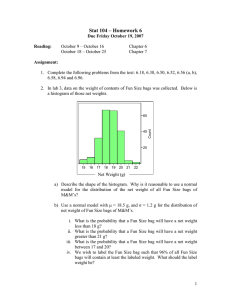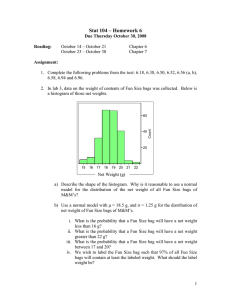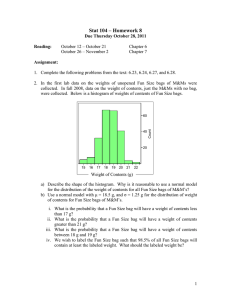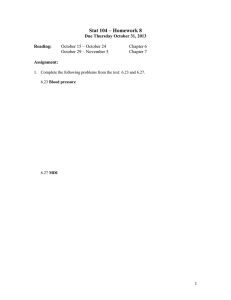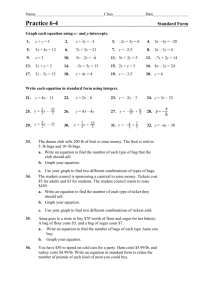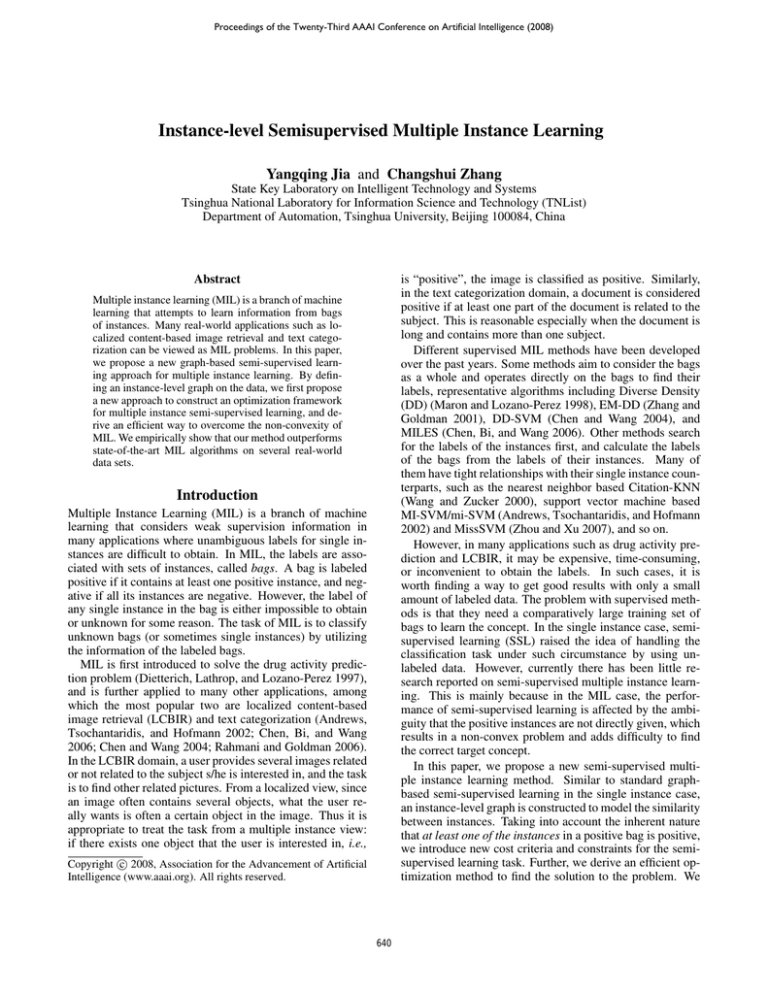
Proceedings of the Twenty-Third AAAI Conference on Artificial Intelligence (2008)
Instance-level Semisupervised Multiple Instance Learning
Yangqing Jia and Changshui Zhang
State Key Laboratory on Intelligent Technology and Systems
Tsinghua National Laboratory for Information Science and Technology (TNList)
Department of Automation, Tsinghua University, Beijing 100084, China
Abstract
is “positive”, the image is classified as positive. Similarly,
in the text categorization domain, a document is considered
positive if at least one part of the document is related to the
subject. This is reasonable especially when the document is
long and contains more than one subject.
Different supervised MIL methods have been developed
over the past years. Some methods aim to consider the bags
as a whole and operates directly on the bags to find their
labels, representative algorithms including Diverse Density
(DD) (Maron and Lozano-Perez 1998), EM-DD (Zhang and
Goldman 2001), DD-SVM (Chen and Wang 2004), and
MILES (Chen, Bi, and Wang 2006). Other methods search
for the labels of the instances first, and calculate the labels
of the bags from the labels of their instances. Many of
them have tight relationships with their single instance counterparts, such as the nearest neighbor based Citation-KNN
(Wang and Zucker 2000), support vector machine based
MI-SVM/mi-SVM (Andrews, Tsochantaridis, and Hofmann
2002) and MissSVM (Zhou and Xu 2007), and so on.
However, in many applications such as drug activity prediction and LCBIR, it may be expensive, time-consuming,
or inconvenient to obtain the labels. In such cases, it is
worth finding a way to get good results with only a small
amount of labeled data. The problem with supervised methods is that they need a comparatively large training set of
bags to learn the concept. In the single instance case, semisupervised learning (SSL) raised the idea of handling the
classification task under such circumstance by using unlabeled data. However, currently there has been little research reported on semi-supervised multiple instance learning. This is mainly because in the MIL case, the performance of semi-supervised learning is affected by the ambiguity that the positive instances are not directly given, which
results in a non-convex problem and adds difficulty to find
the correct target concept.
In this paper, we propose a new semi-supervised multiple instance learning method. Similar to standard graphbased semi-supervised learning in the single instance case,
an instance-level graph is constructed to model the similarity
between instances. Taking into account the inherent nature
that at least one of the instances in a positive bag is positive,
we introduce new cost criteria and constraints for the semisupervised learning task. Further, we derive an efficient optimization method to find the solution to the problem. We
Multiple instance learning (MIL) is a branch of machine
learning that attempts to learn information from bags
of instances. Many real-world applications such as localized content-based image retrieval and text categorization can be viewed as MIL problems. In this paper,
we propose a new graph-based semi-supervised learning approach for multiple instance learning. By defining an instance-level graph on the data, we first propose
a new approach to construct an optimization framework
for multiple instance semi-supervised learning, and derive an efficient way to overcome the non-convexity of
MIL. We empirically show that our method outperforms
state-of-the-art MIL algorithms on several real-world
data sets.
Introduction
Multiple Instance Learning (MIL) is a branch of machine
learning that considers weak supervision information in
many applications where unambiguous labels for single instances are difficult to obtain. In MIL, the labels are associated with sets of instances, called bags. A bag is labeled
positive if it contains at least one positive instance, and negative if all its instances are negative. However, the label of
any single instance in the bag is either impossible to obtain
or unknown for some reason. The task of MIL is to classify
unknown bags (or sometimes single instances) by utilizing
the information of the labeled bags.
MIL is first introduced to solve the drug activity prediction problem (Dietterich, Lathrop, and Lozano-Perez 1997),
and is further applied to many other applications, among
which the most popular two are localized content-based
image retrieval (LCBIR) and text categorization (Andrews,
Tsochantaridis, and Hofmann 2002; Chen, Bi, and Wang
2006; Chen and Wang 2004; Rahmani and Goldman 2006).
In the LCBIR domain, a user provides several images related
or not related to the subject s/he is interested in, and the task
is to find other related pictures. From a localized view, since
an image often contains several objects, what the user really wants is often a certain object in the image. Thus it is
appropriate to treat the task from a multiple instance view:
if there exists one object that the user is interested in, i.e.,
c 2008, Association for the Advancement of Artificial
Copyright Intelligence (www.aaai.org). All rights reserved.
640
P
the diagonal degree matrix D as Dii = j Wij , and define
the graph Laplacian as L = D−W for the discussion below.
empirically show that our method outperforms state-of-theart MIL algorithms on several real-world data sets.
The Proposed Method
IL-SMIL: Instance-level Semi-supervised
Multiple Instance Learning
First, we propose the following cost criterion that is a multiple instance counterpart of the manifold regularization
framework(Belkin, Niyogi, and Sindhwani 2005):
In this section, after introducing some notations, we formulate the semi-supervised multiple instance learning in an
instance-level way and discuss its solution. We will first define the cost criterion based on instance labels, and then derive an efficient sub-optimum solution to the optimization
task. The label of each bag is then decided by the label of its
corresponding instances.
LB
1 X
V (Bi , yi(B) , f ) + γA kf k2K + γI kf k2I .
LB i=1
(2)
The cost criterion contains one loss function V based on labeled bags, and two regularization terms: kf k2K minimizes
the complexity over a certain Reproducing Kernel Hilbert
Space (RKHS), and kf k2I controls the complexity in the intrinsic geometry of the data distribution. In graph-based
SSL, the term kf k2I is usually approximated by graph Laplacian as
1
kf k2I = 2 f > L f ,
(3)
n
where f = (f1 , · · · , fn )> .
The two regularizers share similar thoughts with single
instance learning, because we assume that the soft labels
are smooth over the instance-level graph, and the function
should have a low complexity in the RKHS. The difficulty
with multiple instance learning is that we cannot write the
loss function in a convex form such as the squared loss in
the single instance case, because the known labels are assigned to bags instead of instances. In the following part,
we discuss the loss function for the positive and negative
bags separately, starting from the squared loss that is used in
most single instance SSL algorithms.
For a negative bag (i = L+ + 1, · · · , LB ), it is straightforward to see that all instances in the bag are negative, i.e.,
yj = −1, for all xj ∈ Bi . Thus we have the penalty term
similar to the loss function of single-instance SSL:
X
V (Bi , yi(B) , f ) =
(fj +1)2 , i = L++1, · · · , LB . (4)
CMI (f ) =
Notations and Assumption
We denote the data by a set of labeled and unlabeled bags
(B)
{(B1 , y1(B) ),
· · · , (BLB , yL
), BLB +1 , · · · , BLB +UB )},
B
where the first LB bags are labeled and the following UB
bags are unlabeled. Each bag Bi is a set of instances, with
its label denoted by yi(B) ∈ {−1, +1}, +1 for positive and
−1 for negative. Without loss of generality, we assume that
the first L+ bags are positive and the following L− bags
are negative (L+ + L− = LB ). We denote the set of all
instances by X = {x1 , x2 , · · · , xn } where xi ∈ Rd is a
d-dimensional feature vector representing an instance, and
n is the number of instances. To describe the relationship
between bags and instances, we use xj ∈ Bi to represent
that “xj is an instance from bag Bi ”. Without loss of
generality, we assume that the first l instances are from
labeled bags. The hidden labels of the instances are denoted
by Y = (y1 , y2 , · · · , yn )> .
The task of MIL is to learn a soft label function f : Rd →
[−1, 1] that learns the label for each instance. We denote the
predicted soft label of instance j by fj = f (xj ). Then, the
labels of the bags can be calculated: when the labels take
discrete value from {−1, 1}, a bag’s label is 1 if and only
if at least one of its instances’ labels is 1. For the soft label
case, we define a bag Bi ’s soft label fi(B) to be determined
by the largest value of its instances’ soft labels:
fi(B) = max fj .
j,xj ∈Bi
j:xj ∈Bi
(1)
Meanwhile, for a positive bag, the case is more complex because positive bags may contain negative instances as well.
Actually, only one positive instance is necessary to determine a positive bag. Thus, we define the penalty term for a
positive bag to be only related to the instance with the largest
soft label:
Note again that for either labeled or unlabeled bags, whether
a certain instance is positive or negative is unknown to the
user. This is essentially what “multiple instance” means.
Instance-level graph
V (Bi , yi(B) , f ) = (1 − max fj )2 ,
Generally, we assume that all bags are drawn independently
from the data distribution, and that the positive instances lie
in a certain region in the feature space while the negative
ones lie in the remaining space. We also assume that the
(soft) label over the feature space is smooth, which is also
assumed in most semi-supervised learning methods, and are
usually satisfied in most real-time scenarios. Similar to standard SSL, we use an n × n weight matrix W to model the
instance-level graph: Wij is nonzero if and only if instance i
is among the k-nearest neighbors of instance j or vice versa.
In our paper, we use the Gaussian kernel to calculate the
weight as Wij = exp{−γkxi − xj k2 }. Further, we define
j:xj ∈Bi
i = 1, · · · , L+ . (5)
Note that we do not impose any penalty term on the instances of the bag other than the one with the largest soft
label. Some MIL methods (such as mi-SVM and MissSVM)
try to determine the labels of all the instances in the positive
bag, and attempt to impose a large margin criterion by pushing the soft labels of all the instances to either −1 or 1. However, in many applications such as drug activity prediction
and text classification, the change of the instances’ labels is
considered to be continuous. Then, if positive and negative
instances exist simultaneously in a certain bag, there must
641
extension of (Yuille and Rangarajan 2003), and is theoretically guaranteed to converge. It works in an iterative way:
at each iteration, the 1-st order Taylor expansion is used to
approximate the non-convex functions, and the problem is
thus approximated by a convex optimization problem. The
sub-optimum solution is given by iteratively optimizing the
convex subproblem until convergence.
Since the max(·) function is not differentiable at all
points, we employ its subgradient to approximate the 1-st
Taylor expansion at the k-th iteration with starting point
(k)
(k)
f (k) = (f1 , · · · , fn )> . For the max(·) function related
to bag Bi , its 1-st order Taylor expansion is approximated as
(k)
(k)
max fj
≈ max fj + ∆>
), (10)
i (f − f
be some instances that are close to the decision boundary.
Thus, the large margin criterion may not work well in this
case, because such labels are inherently ambiguous. Similar arguments have also been proposed in (Zhang and Oles
2000) and (Zhou and Xu 2007).
Thus, we have the following cost criterion for IL-SMIL:
+
C(f )
=
γA kf k2K
+
γI kf k2I
L
X
+
(1 − max fj )2
j:xj ∈Bi
i=1
+γL
LB
X
X
(fj + 1)2 .
(6)
i=L+ +1 j:xj ∈Bi
Because the loss function penalty terms for positive and negative bags have different mathematical forms, a parameter
γL is used to balance the weight.
Once we have found the optimal labels of the instances
by minimizing the cost criterion C(f ), the bag-level label of
any bag Bi can be calculated by taking the maximum value
of its instances’ labels using (1). The only problem left is
how to solve the optimization task: due to the existence of
the max(·) function in the loss function for positive bags,
C(f ) is generally non-convex, and cannot be directly optimized. In the following part we will derive a sub-optimum
solution to the problem.
j:xj ∈Bi
where the subgradient ∆i is an n × 1 vector whose j-th element is given by
(k)
1
= ζi
ni , xj ∈ Bi and fj
∆ij =
.
(11)
0,
otherwise
(k)
In the equation above, ζi = maxj:xj ∈Bi fj is the largest
label value in Bi , and ni is the number of instances that have
the largest label value ζi . In another word, at every iteration,
only the instance (or instances) with the largest label value
in Bi is considered in the constraint.
In brief, for the k-th iteration of CCCP, we keep the cost
function (7) and constraint (9), and rewrite the non-convex
constraint (8) given the previous iteration’s output f (k) :
Iterative Solution Using CCCP
First, we rewrite the problem in an alternative way by introducing hinge loss parameters:
(k)
1 − max fj
+
arg min
f
γA kf k2K + γI kf k2I +
L
X
j:xj ∈Bi
ξ2
LB
X
X
(fj + 1)2
(7)
1 − max fi 6 ξi ,
j:xj ∈Bi
ξi > 0,
(12)
Kernel Based Representation
i=L+ +1 j:xj ∈Bi
s.t.
(k)
− ∆>
) 6 ξi .
i (f − f
This is a linear constraint. The subproblem formed by (7),
(12) and (9) is thus convex, whose optimum solution can be
calculated within quadratic time complexity.
i=1
+γL
j:xj ∈Bi
f (k)
+
i = 1, · · · , L
i = 1, · · · , L+ .
In the multiple instance case, the Representer Theorem
for manifold regularization (Belkin, Niyogi, and Sindhwani
2005) still holds, i.e., the minimizer of the optimization
problem admits an expansion
n
X
f ∗ (x) =
αi K(xi , x),
(13)
(8)
(9)
This problem is slightly different from the original one.
Compare the original cost function (6) and the rewritten cost
function (7), if |fi | 6 1 stands for all i = 1, · · · , n, the two
function values are strictly equivalent. When there exists
some fi that satisfies |fi | > 1, the criterions (6) and (7) differ in the way of treating these “too correct” values, as the
former one imposes penalty while the latter one does not.
However, it is worth pointing out that the optimum solutions
to the two problems both satisfy |fi | 6 1, ∀i = 1, · · · , n
(We omit the proof due to space limit here). Thus, rewriting the problem does not affect the optimum solution to the
original cost criterion.
Consider the rewritten problem (7)-(9), we can see that
the object function is convex, and the L+ constraints (8) are
non-convex but each is the difference between the constant
value 1 and a convex max(·) function (with respect to f ).
Thus, we adopt the constrained concave convex procedure
(CCCP) to find the sub-optimum solution. CCCP is proposed in (Smola, Vishwanathan, and Hofmann 2005) as an
i=1
where K(·, ·) is the reproducing kernel of the RKHS. Then,
we are able to solve the problem using the n-dimensional
expansion coefficient vector α = (α1 , · · · , αn )> . In detail,
the subproblem for the k-th iteration of CCCP with respect
to α is:
+
arg min
α
L
X
γI
ξ2
γA α Kα + 2 α> K > LKα +
n
i=1
>
+γL
s.t.
LB
X
X
i=L+ +1
j:xj ∈Bi
(14)
(k)
1 − max Kj· α(k) − ∆>
) 6 ξi
i (Kα − Kα
suBi
ξi > 0,
642
(Kj· α + 1)2
i = 1, · · · , L+ ,
Positive
Negative
(a) Instance-level
Pos bag
performance is greatly affected if the number of instances
(and positive instances) per bag varies greatly among different bags, which is very common in real-world applications. Also, the accuracy of the weight (or “energy” as called
in (Rahmani and Goldman 2006)) plays an important role,
but due to the Diverse Density nature of the calculation, it
might not be easy to get accurate energy values with a small
amount of training bags, which again results in the ambiguity of the bag-level graph structure. Moreover, the bag-level
graph sacrifices the information of instance-level relationships and only stores relationship between bags. This may
affect the final result of the method. It is also difficult to
discuss how the bags distribute in the abstract “bag-level”
space, or whether the distribution satisfies semi-supervised
learning’s assumptions.
On the contrary, an instance-level graph has several advantages over the bag-level graph. First, it is a straightforward representation of the graph-based learning, and does
not need to translate the instance-level similarity measure to
the bag-level, which is often heuristic and may bring unnecessary loss of information. Also, the structure of the
instance-level relationship has a solid theoretical foundation
from the heat kernel and the spectral graph theory (Chung
1997). Actually, one of the major reasons for constructing
a bag-level graph is to circumvent the non-convexity problem. We have shown that in our method, the non-convexity
of the multiple instance learning has been efficiently solved
by our framework together with CCCP, which works well
according to the experimental results.
Neg bag
(b) Bag-level
Figure 1: The instance-level and the bag-level graph. The
+/- symbols are instances, the black lines are edges in the
graph structure, and the dashed circles indicate positive and
negative bags.
where with a slight abuse of notation, we use K as the Gram
matrix over all instances, and Kj· as the j-th row of K. This
subproblem is a standard quadratic programming (QP) problem and can be solved by any state-of-the-art QP solvers.
Running CCCP iteratively until convergence, we can obtain
the sub-optimum solution for the instance labels. The label
for each bag is then calculated as the largest label of all its
instances using (1).
It is worth pointing out that manifold regularization is a
general form of several semi-supervised learning methods
such as the Gaussian random fields and harmonic function
method (Zhu, Ghahramani, and Lafferty 2003), the local and
global consistency method (Zhou et al. 2003), etc. Thus
these methods can be easily extended to the multiple instance case using our derivation. Also, our IL-SMIL can be
naturally extended to induction similar to (Belkin, Niyogi,
and Sindhwani 2005).
Experiments and Discussion
We evaluate the performance of our method and compare
it with the MISSL method on three real-world data sets,
namely drug activity prediction, LCBIR, and text categorization1 . For drug activity prediction, results from two representative supervised methods, namely EMDD and multiple instance SVM, are also reported to test the efficiency of
SSL. In all our experiments, the performance is evaluated by
the area under the Receiver Operating Characteristic (ROC)
curve, abbreviated as AUC, which shows the tradeoff between sensitivity and specificity.
All results reported here are averaged over 20 independent runs. The features are normalized to [0, 1]. For our
method, the graph is constructed with parameters k = 15,
γ = 0.05 for drug activity prediction and LCBIR, and
k = 30, γ = 0.5 for text categorization due to large data
numbers and sparse features. In the experiments, we fix the
B
parameter γL as γL = #P
#N I , where #N I is the number of
labeled negative instances and #P B is the number of labeled positive bags. Parameters γA and γI are determined
by cross validation and a grid search from 10−3 to 104 . We
simply use a linear kernel for the RKHS norm. For the parameters of the MISSL method, we fix F = 0.1 and use a
grid search for γ (taking integer value from 1 to 4), σ (from
0.01 to 1), and the other parameters for later bag-level SSL.
The best result is reported here.
Instance-level vs. Bag-level
For the combination of MIL and SSL, (Rahmani and Goldman 2006) has raised the multiple instance SSL problem for
CBIR, and proposed a graph-based algorithm called MISSL.
The main thought of MISSL is to convert each bag into a
single node in the graph. To perform this, it first calculates
the similarity between instances via a heat kernel, and uses
Diverse Density criterion to calculate the “energy” of each
instance, which can be interpreted as the probability that the
instance is positive. Then, a bag-level graph is constructed,
whose nodes are bags and edges are pairwise similarities between bags. A standard SSL algorithm is implemented to get
the labels of the bags. An example of the instance-level and
bag-level graph is shown in Figure 1.
The aim of the bag-level graph is to fit the MIL problem into the classical SSL framework, and to circumvent the
non-convexity problem due to the weak supervision information. This is done by defining a way to represent relationship between bags. However, a bag-level graph may suffer from several shortcomings. First, the similarity between
two bags is calculated by a weighted sum of the pairwise
similarity between its instances, which is somehow heuristic
and does not have a sound theoretical support. Actually, its
1
The LCBIR and text categorization data sets can be found at
http://www.cs.columbia.edu/˜andrews/mil/datasets.html.
643
Method
EMDD
Poly
MI-SVM linear
RBF
Poly
mi-SVM linear
RBF
MISSL
IL-SMIL
Musk1
73.22±6.01
64.51±14.63
65.43±11.74
70.79±10.23
69.61±7.28
68.37±7.32
73.52±7.75
76.61±2.71
84.17±4.83
Musk2
75.10±5.94
74.37±8.85
71.09±10.89
80.07±8.24
71.09±10.53
67.76±11.20
77.70±8.96
71.58±2.78
83.79±4.23
Dataset
Elephant
Tiger
Fox
TST1
TST2
TST3
TST4
TST7
TST9
TST10
Table 1: The area under the ROC curve (AUC) in percentage
on Musk.
MISSL
78.75±2.86
74.71±3.90
61.12±3.53
63.38±1.99
51.63±1.43
54.02±1.90
52.49±2.08
54.05±1.45
59.43±2.26
62.22±2.25
IL-SMIL
82.06±2.70
80.31±3.32
57.05±4.59
84.72±3.02
62.60±1.93
60.98±2.92
65.59±3.59
60.50±2.99
64.70±3.62
67.59±3.32
Table 2: Results of LCBIR and Text Categorization.
Drug Activity Prediction
performs competitively in the LCBIR tasks.
The Musk data set is available from the UCI Repository
(Asuncion and Newman 2007). It contains two subsets:
Musk1 has 47 positive bags and 45 negative bags with an average of about 5.2 instances per bag; Musk2 has 39 positive
bags and 63 negative bags, and the number of instances in
each bag is much larger, and differs more significantly than
Musk1, ranging from 1 to 1,044 (about 64.5 instances per
bag in average). For both sets, each instance is described
by a 166-dim vector. We use 5 labeled positive bags and
5 labeled negative bags for Musk1, and 10 respectively for
Musk2. The results are presented in Table 1. For the supervised learning methods, their parameters are tuned in a grid
search way similar to MISSL.
It can be seen that our method outperforms all other methods on both data sets, especially on Musk1. Also, for
Musk1, the two semi-supervised method are superior to all
the supervised methods. For Musk2, although MISSL performs poorer (possibly because the number of instances in a
bag is much inconsistent between bags), our method is still
performing better than the other algorithms. This indicates
that for multiple instance problems, employing information
about the unlabeled bags is useful for better classification.
Moreover, the experiments show that the AUC values of all
supervised methods have a large deviant, indicating that the
performance is unstable and relies much on the selection
of the labeled data. On contrary, the two semi-supervised
learning methods are more stable, which is another advantage of utilizing unlabeled bags.
Text Categorization
The text categorization data set contains seven sets, each
containing 200 positive and 200 negative bags with about
3330 instances. We report the result of our method and
MISSL in Table 2. 30 positive and 30 negative bags are
labeled to perform semi-supervised learning. For simplicity, the parameters are tuned solely on TST1, and the best
parameter is then applied for all other sets. Our method outperforms MISSL on all 7 data sets, with an increase of about
eight percent on average.
Further, we test the performance under different numbers
of both labeled and unlabeled bags. The results on TST1-3
(the others are omitted for simplicity) are shown in Figure 2.
For the first row, we vary the number of labeled bags from 5
to 50 for both positive and negative bags, and use the other
bags as unlabeled data; for the second row, we fix the number of labeled bags to 30 positive and 30 negative, and vary
the number of unlabeled bags from 40 to 340. The learning
curves showed the superiority of our method over MISSL
in most of the cases. Also, a larger number of bags (both
labeled and unlabeled) bring up two results: (1) they help
to increase the AUC, and (2) they make the result of the algorithm more stable (i.e., a smaller standard deviant). Note
again that adding unlabeled bags improves the performance,
which indicates that unlabeled data is useful for better classification in multiple instance learning.
Conclusion
Localized Content-based Image Retrieval
In this paper, we proposed a novel algorithm for semisupervised multiple instance learning from an instance-level
view. We used the instance-level graph to describe the relationship between instances, and designed IL-SMIL similar
to manifold regularization for semi-supervised multiple instance learning. We derived the loss function for positive
and negative bags respectively, and employed an efficient
CCCP algorithm to perform optimization. The spirit of our
method roots from the standard semi-supervised learning
theory. It is firmly supported both empirically and theoretically by previous literature, and can naturally be extended to
induction. The experiments over different real-world applications have shown the superiority of our method.
We use the Elephant, Tiger and Fox data sets from (Andrews, Tsochantaridis, and Hofmann 2002) for experiments
on the LCBIR application. Each of the three data sets contains 100 positive bags and 100 negative bags of about 1300
instances. Each bag represents an image, and instances in a
bag represent different segmented blobs of the corresponding image. We use 10 labeled positive bags and 10 labeled
negative bags for all three data sets. The result is shown in
Table 2. It can be seen that our method performs better than
MISSL on Elephant and Tiger, while on Fox MISSL performs slightly better than ours. As MISSL is initially proposed to solve the LCBIR problem, we infer that our method
644
TST1, L changes
0.9
0.7
0.8
0.65
0.6
0.5
0.6
0.55
0.6
0.55
20
30
+ −
L /L
40
50
0.4
60
TST1, U changes
MISSL
IL−SMIL
10
20
AUC
0.7
0.6
40
50
60
0.4
0
MISSL
IL−SMIL
0.7
0.7
0.65
0.65
0.6
0.6
0.55
100
200
UB
300
400
20
30
+ −
L /L
40
50
60
TST3, U changes
0.55
0.5
0.45
0.4
0
10
0.75
0.5
0.5
0
TST2, U changes
0.75
0.8
30
+ −
L /L
MISSL
IL−SMIL
0.35
AUC
10
0.4
0
0.5
0.45
0.45
MISSL
IL−SMIL
0.9
AUC
0.65
0.5
0.4
TST3, L changes
0.7
AUC
0.7
0
TST2, L changes
0.75
AUC
AUC
1
MISSL
IL−SMIL
100
200
UB
300
400
0.45
0.4
0
MISSL
IL−SMIL
100
200
UB
300
400
Figure 2: Learning curves on TST1-3 (with standard deviation shown as error bars).
Another potential advantage of our method is that it gives
detailed information about the labeling of instances. On a
bag-level graph this is not direct, as the prediction is only
made on the bag level. This advantage enables us to look
into the instance-level structure of the problem. We will focus on utilizing such information in our future work.
Maron, O., and Lozano-Perez, T. 1998. A framework for
multiple-instance learning. Advances in Neural Information Processing Systems 10:570–576.
Rahmani, R., and Goldman, S. 2006. MISSL: Multiple instance semi-supervised learning. Proc. International Conference on Machine Learning 705–712.
Smola, A.; Vishwanathan, S.; and Hofmann, T. 2005.
Kernel methods for missing variables. Proc. International
Workshop on Artificial Intelligence and Statistics.
Wang, J., and Zucker, J. 2000. Solving the multipleinstance problem: A lazy learning approach. Proc. International Conference on Machine Learning 1119–1125.
Yuille, A., and Rangarajan, A. 2003. The Concave-Convex
Procedure. Neural Computation 15(4):915–936.
Zhang, Q., and Goldman, S. 2001. EM-DD: An improved
multiple-instance learning technique. Advances in Neural
Information Processing Systems 14:1073–1080.
Zhang, T., and Oles, F. J. 2000. A probability anaylsis
on the value of unlabeled data for classification problems.
Machine Learning 17:1191–1198.
Zhou, Z., and Xu, J. 2007. On the relation between multiinstance learning and semi-supervised learning. Proc. International Conference on Machine Learning.
Zhou, D.; Bousquet, O.; Lai, T.; Weston, J.; and Scholkopf,
B. 2003. Learning with Local and Global Consistency.
Advances in Neural Information Processing Systems.
Zhu, X.; Ghahramani, Z.; and Lafferty, J. 2003. Semisupervised learning using Gaussian fields and harmonic
functions. Proc. International Conference on Machine
Learning.
Acknowledgement
This work is supported by the National Natural Science
Foundation of China (Grant No. 60721003, 60675009).
References
Andrews, S.; Tsochantaridis, I.; and Hofmann, T. 2002.
Support vector machines for multiple-instance learning.
Advances in Neural Information Processing Systems.
Asuncion, A., and Newman, D. 2007. UCI machine learning repository. http://www.ics.uci.edu/˜mlearn/ MLRepository.html.
Belkin, M.; Niyogi, P.; and Sindhwani, V. 2005. On manifold regularization. Proc. International Workshop on Artificial Intelligence and Statistics.
Chen, Y., and Wang, J. 2004. Image Categorization by
Learning and Reasoning with Regions. The Journal of Machine Learning Research 5:913–939.
Chen, Y.; Bi, J.; and Wang, J. 2006. MILES: MultipleInstance Learning via Embedded Instance Selection. IEEE
Trans Pattern Anal Mach Intell 28(12):1931–1947.
Chung, F. 1997. Spectral Graph Theory. American Mathematical Society.
Dietterich, T.; Lathrop, R.; and Lozano-Perez, T. 1997.
Solving the multiple instance problem with axis-parallel
rectangles. Artificial Intelligence 89(1):31–71.
645

